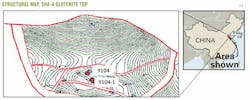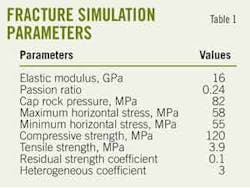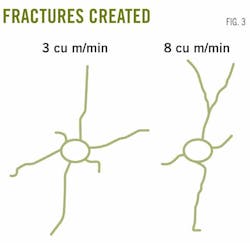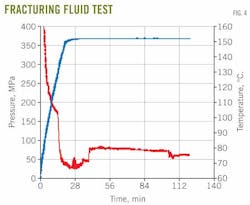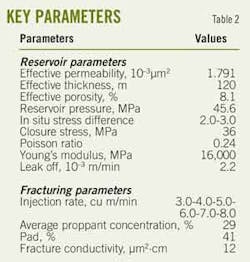Model optimizes sandstone-conglomerate fracturing in China
Weiqiang Feng
Sinopec Research Institute of Petroleum Engineering
Beijing
Qi Li
Xi’an Shiyou University
Shannxi, China
Jian Wang
Sinopec
Shandong, China
A stimulation model helped optimize hydraulic fracturing of a sandstone-conglomerate (glutenite) formation in the Bohan oil field in eastern China.
The formation is difficult to fracture because it has low maturity and texture, strong heterogeneity and anisotropy, and various porosity types.
Bonan field
Bonan oil field is in the Jiyang depression of the onshore Bohai basin, Eastern China (Fig. 1).
Discovered in May 2005 with wildcat well Y104, the reservoir has a 110-m thickness. After initial hydraulic fracturing, the well produced only 3.28 cu m/day.
The main reservoir, informally named the Sha-4 glutenite formation, is part of the Eocene Shahejie formation. The formation contains sediments that were deposited quickly and near the source of clastics.
The field has an estimated 14.5 million cu m of original oil in place and covers 9.11 sq km. Reservoir temperature is 141-150° C. at a 3,450-4,800 m depth. Reservoir thickness is 100-700 m.
The reservoir is a fan-shaped anticline structure that was uplifted from south to north. Stratigraphic dip is 2-6°, and the subsurface depth of the structural high is 3,540 m.
The presence of east west to east south, east north and north faults formed the trap that is compartmentalized in several structure blocks by secondary faults (Fig. 1).
The reservoir rocks are a conglomerate of pebbly sandstone, siltstone, andesite, dolerite, and dolomite siltstones. The reservoir has:
• A complicated content of 33.4% quartz, 31% feldspar, 35.6% lithic clastics, 13% clay, and 29.76% other clastics.
• Strong heterogeneity with a 1.685-4.113 sorting coefficient.
• Medium 0.05-0.017 mm grain size.
• Poor reservoir characteristics of mainly secondary dissolved porosity and muddy microporosity. Average porosity and permeability is 8.5% and 0.23 md, respectively.
• A strong water-wet and strong water sensitivity.
• An internal baffle zone with a poor seal in the vertical direction, based on composite log analysis.
Rock properties
Core analysis shows that the rock has low tensile and compressive strength, strong stress sensitivity, high plasticity, and high horizontal stress. Based on experiments, the rock’s mechanical parameters are 3.9 MPa tensile strength, 92 MPa compressive strength, 16,000 MPa elastic modulus, 0.27 Poisson’s ratio, and 0.513 Biot factor.
Stress sensitivity damage decreases core permeability by 74.67%.
Hydraulic fracturing simulation based on the rock properties and core experiments indicated that:
• Multifractures may form near the wellbore.
• Drainage area decreases because of the strong heterogeneity and poor reservoir properties.
• Fractures will grow beyond the formation in the vertical direction because of low stress difference between the pay zone and seal rock
• High plasticity will allow proppant to embed into the pay zone.
• Fracture conductivity will decrease.
• Fracture permeability will decrease because of the high stress sensitivity.
• Formation damage will occur because of high reservoir temperature and a strong water-wet rock.
The lithology and reservoir properties vary in the vertical and horizontal directions. The rock is poorly sorted and has poor connectivity.
Key elements in successful fracturing are the improving of fracturing fluid properties and controlling the geometry of the fractures to connect more drainage area.
Simulation model
Reservoir permeability decreases from west to east and increases from the edge to the center in the south-north direction. The heterogeneity coefficient and permeability differential are 1.2 and 1.5, respectively.
In the vertical direction, reservoir permeability decreases from top to bottom.
Parameters in the simulation model included the permeability distribution, oil viscosity, oil saturation, effective thickness, fracture length, fracture height, fracture conductivity, and data from five exploration wells.
The simulation used a multifactor sensitivity analysis for obtaining a suitable reservoir production model.
The model size was 50 by 350 by 120 m, and contained 23,100 (55 by 35 by 12) grids. The fracture orientation used was northeast 110°.
A local infill grid (2 by 2 by 2 m) improved the fracture grid.
A multifactor regression analysis established the reservoir production model with seven parameters in Equations 1-3 (see equation box).
According to the simulation, the optimum fracture parameters were 145-75 m length, 50-70 m height, and 10-15 μm2/cm conductivity.
A Weibull distribution described rock heterogeneity (Equation 4).
In the equation, α is the mechanics parameter such as strength, elastic modulus etc. The α0 is the average value of mechanics parameter, m is heterogeneity coefficient, and ψ(α) is the statistical distribution density. A larger homogeneity coefficient indicates a less homogeneous rock.
The distribution of reservoir parameters in the horizontal and vertical directions was forecast based on reservoir heterogeneity and well log data from five exploration wells. Table 1 lists the rock’s mechanical parameters required by the software for the glutenite reservoir .
Fig. 3 shows the finite element model of the hydraulic fracture, and Fig. 4, the fractures created with injection rates or 3.0 cu m/min and 8.0 cu m/min.
With the higher injecting rate, the fracture extension is less in the horizontal direction but much larger in the vertical direction. This means that the job created multifractures with a low average fracture conductivity.
When the rock had strong heterogeneity and a large difference between maximum and minimum horizontal stress, the fracture extension was straight. The random distribution of rock grains will make the stress nonuniform in the reservoir and create a high stress in a local area, which results in fracture extensions along the low stress direction.
Field application
The optimized fracturing simulation was used first in well Y104-1. The well is at a 3,822 m depth at the Sha-4 member and had a perforation interval of 3,715-35 m.
The Sha-4 reservoir has a 8.1% porosity, 1.791 × 10–3μm2 permeability, 12.83% muddy content, and 26.185% glutenite content.
The optimized fracture parameters were designed in which the fracture half length was 145-75 m, fracture height was 145-75 m, and fracture conductivity was 10-15 μm2/cm. The design controlled the multifractures near the wellbore.
Table 2 lists the key parameters of the well. The simulation resulted in a 141.9-m fracture half length, 65.8-m fracture height, and 4.19 mm fracture width.
The formula for the polymer clean fracturing fluid was 0.9% SRCF-1 + 0.45% SRCF-1B + 0.4% SRCF-1A. In the formula SCRF-1 is a polymer gelling agent, SCR-1A is a rheological modifier for SCRF-1, and SCRF-1B is a temperature stabilizer for SCRF-1.
The fracturing fluid viscosity was greater than 70 mPa-sec after 2 hr of 170 sec–1 shearing at 150° C. From core tests, the fluid’s damage rate was about 14.71%.
The fluid had good proppant carrying and low damage characteristics that met the operational needs.
The optimized perforation interval was 3,715-35 m for the 77 m fracturing interval. The treatment included proppant densities of 1,810 kg/cu m, 1,650 kg/cu m, and 1,470 kg/cu m. Injection rates varied for 3 to 8 cu m/min.
At the beginning of fracturing, the injection rate was low to prevent generation of multifracture near the wellbore. The rate was increased step by step to generate multifractures away from the wellbore. These multifractures increased well drainage area and contacted more reserves.
A preflush slug with a small diameter ceramic proppant was for preventing fluid leakoff, cleaning the perforation holes, and reducing the risk during the high proppant concentration stage.
A high quality temporary plugging agent was pumped to plug microfracture and improve the effectiveness of the fracturing fluid.
During flowback, liquid nitrogen was injected to increase flowback rates and reduce formation damage.
A high quality antiswelling agent was included for reducing water damage.
The hydraulic fractioning of Well Y104-1 was successful, and the well produced 6,327.5 cu m of liquid and 5,253 cu m of oil within 168 days. Wellhead pressure decreased to 7.6 MPa from 27 MPa previously. Initial production rate of the well with natural flow after fracturing was 58.6 cu m/day liquid, 39.6 cu m/day oil, and 1.4 × 104 cu m of gas.
Fracture monitoring with microseismic showed that the main fracture had two wings. One wing extended southwest, the other northeast and then separated toward the north and northeast.
The fracture orientation was northeast 40°, northeast 0°, and northeast 70°. Total fracture length was more than 300 m (Fig. 5).
The microseismic involved a wave detector placed in an adjoining well.
Some lessons learned from the work were that for glutenite reservoir hydraulic fracturing, the fracturing size should be longer than usual, and that one should generate multifractures away from the wellbore and not near the wellbore.
Also the fracturing fluid needs to withstand high temperature and shearing.
The authors
More Oil & Gas Journal Current Issue Articles
More Oil & Gas Journal Archives Issue Articles
View Oil and Gas Articles on PennEnergy.com

